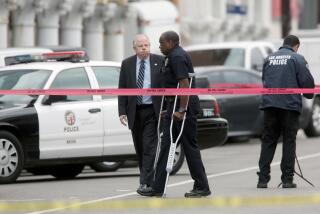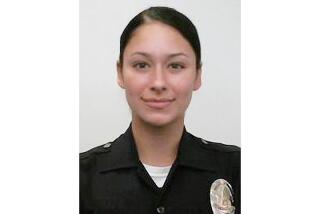Chief Is Said to Fault Officer for Not Disarming Woman
- Share via
The Los Angeles police officer who fatally shot a mentally ill homeless woman apparently had an opportunity to disarm her when she placed the screwdriver she allegedly was brandishing in a shopping cart and then pushed it toward the officer, according to sources familiar with the LAPD’s investigation.
In his report to the Police Commission, Chief Bernard C. Parks said Officer Edward Larrigan used poor tactics when he pushed the shopping cart back at Margaret Mitchell, an apparent gesture of defense that allowed her to rearm herself, sources said.
Larrigan shot Mitchell, 55, shortly thereafter when she allegedly lunged at him with the foot-long screwdriver.
Parks also criticized Larrigan for positioning himself too closely to Mitchell, increasing his risk of injury, sources said. Larrigan’s actions resulted in the chief’s ruling of “administrative disapproval” on tactics, sources said. If upheld by the Police Commission, such a finding opens Larrigan to discipline.
Nonetheless, Parks found the overall shooting incident “in policy,” sources said.
Mitchell was shot May 21, as she pushed her shopping cart on a sidewalk at the intersection of 4th Street and La Brea Avenue near Hancock Park. Patrolling the area on their bikes, Larrigan and his partner, Kathy Clark, stopped Mitchell to determine whether the shopping cart was stolen.
The shooting ignited a firestorm of civic controversy in which critics demanded to know why the officers had not used nonlethal means, such as pepper spray, to subdue the diminutive woman. For a week after the shooting, there were daily protests by community activists.
Wednesday, Larrigan’s attorney, Hank Hernandez, defended his client’s conduct. He said Larrigan and his partner had been directed by their superiors to concentrate on the theft of shopping carts in their patrol area. He accused LAPD officials of issuing such orders simply to drive down statistics on minor crimes. “It’s not like [Larrigan and Clark] were picking on these homeless people out of the blue,” he said.
According to police, when Larrigan and Clark approached Mitchell, she immediately became hostile, threatening to kill the two officers. A passing motorist stopped and tried to intervene, unsuccessfully urging Mitchell to heed the officers’ commands to stop. But Mitchell continued to walk away.
At some point, sources said, the departing woman shoved her cart at Larrigan, who pushed it back at her in an attempt to keep the cart between them.
When the officers attempted to stop her again, she allegedly lunged at them with the screwdriver. Larrigan lost his balance. Allegedly feeling threatened by the screwdriver-wielding Mitchell, the officer shot her once in the chest. Mitchell died about 30 minutes later.
Although police officials said numerous civilian witnesses at the busy intersection back the officers’ version of events, two witnesses said in independent interviews with The Times that Mitchell never lunged at the officers with her screwdriver. On the contrary, they said, Mitchell was fleeing the officers when she was shot.
Parks’ report, which was forwarded to the Police Commission last week, goes into great detail about the shooting and the officers’ actions. The report also mentions that Mitchell had been detained by police on several occasions on suspicion of stealing shopping carts before the day she was shot, sources said.
Hernandez, Larrigan’s attorney, said he “strongly” disagrees with the chief’s findings. He said the chief’s report also criticizes the officers’ communications with each other and radio broadcasts to others.
The lawyer said that any mistakes the officers made did not rise to the level of misconduct. “There is absolutely no other conclusion than that the use of force was legally justified,” Hernandez said.
At least some commissioners, sources said, are troubled by the account described in the chief’s report and have concerns that all the facts are not presented accurately.
Several commissioners, including two this week, have taken the unusual step of visiting the spot where Mitchell was shot as part of their review of the shooting. Commissioners also are expected to listen to the department’s taped interviews of witnesses to determine whether LAPD investigators accurately summarized their statements.
Additionally, the commission’s inspector general is examining the chief’s report and the department’s investigation.
The civilian body’s scrutiny of the case, however, does not mollify some LAPD critics.
In a news conference Tuesday, Leo James Terrell, the attorney for Mitchell’s family, voiced his outrage that Parks found the Mitchell shooting “in policy” and demanded that the chief quit his post immediately.
Parks, Terrell said, “is an embarrassment, he should quit right now. He’s insulted everyone’s intelligence.”
Terrell alleged that Parks was trying to cover up the circumstances of Mitchell’s shooting.
“This has to stop. If the district attorney doesn’t file charges, all hell is going to break loose,” Terrell said.
Earl Ofari Hutchison, director of the National Alliance for Positive Action, said at the news conference that in the face of what he regards as the LAPD’s inadequate response, the Mitchell case “is a litmus test” for the U.S. attorney, the Justice Department and its Civil Rights Division to prove they can “do their job.”
*
Times staff writer Sylvia Pagan Westphal contributed to this story.
More to Read
Sign up for Essential California
The most important California stories and recommendations in your inbox every morning.
You may occasionally receive promotional content from the Los Angeles Times.










